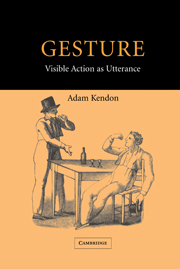Book contents
- Frontmatter
- Contents
- Acknowledgments
- 1 The domain of gesture
- 2 Visible action as gesture
- 3 Western interest in gesture from Classical Antiquity to the eighteenth century
- 4 Four contributions from the nineteenth century: Andrea de Jorio, Edward Tylor, Garrick Mallery and Wilhelm Wundt
- 5 Gesture studies in the twentieth century: recession and return
- 6 Classifying gestures
- 7 Gesture units, gesture phrases and speech
- 8 Deployments of gesture in the utterance
- 9 Gesture and speech in semantic interaction
- 10 Gesture and referential meaning
- 11 On pointing
- 12 Gestures of ‘precision grip’: topic, comment and question markers
- 13 Two gesture families of the open hand
- 14 Gesture without speech: the emergence of kinesic codes
- 15 ‘Gesture’ and ‘sign’ on common ground
- 16 Gesture, culture and the communication economy
- 17 The status of gesture
- Appendix I Transcription conventions
- Appendix II The recordings
- References
- Index
6 - Classifying gestures
Published online by Cambridge University Press: 05 February 2015
- Frontmatter
- Contents
- Acknowledgments
- 1 The domain of gesture
- 2 Visible action as gesture
- 3 Western interest in gesture from Classical Antiquity to the eighteenth century
- 4 Four contributions from the nineteenth century: Andrea de Jorio, Edward Tylor, Garrick Mallery and Wilhelm Wundt
- 5 Gesture studies in the twentieth century: recession and return
- 6 Classifying gestures
- 7 Gesture units, gesture phrases and speech
- 8 Deployments of gesture in the utterance
- 9 Gesture and speech in semantic interaction
- 10 Gesture and referential meaning
- 11 On pointing
- 12 Gestures of ‘precision grip’: topic, comment and question markers
- 13 Two gesture families of the open hand
- 14 Gesture without speech: the emergence of kinesic codes
- 15 ‘Gesture’ and ‘sign’ on common ground
- 16 Gesture, culture and the communication economy
- 17 The status of gesture
- Appendix I Transcription conventions
- Appendix II The recordings
- References
- Index
Summary
This chapter continues our examination of the history of the study of gesture by offering a comparative review of how gestures have been classified, from Quintilian to the twentieth century. The different classification schemes offered reflect the different ways in which gesture has been viewed as a form of expression or communication. As we shall see, gestures have been classified according to many different criteria, such as whether they are voluntary or involuntary; natural or conventional; whether their meanings are established indexically, iconically, or symbolically; whether they have literal or metaphorical significance; how they are linked to speech; their semantic domain - for example, gestures have been divided into those that are ‘objective’, serving to refer to something in the external world, and those that are ‘subjective’, serving to express the gesturer's state of mind. Gestures have also been classed according to whether they contribute to the propositional content of discourse, whether they serve in some way to punctuate, structure or organize the discourse, or indicate the type of discourse that is being engaged in; and whether they play a primary role in the interactional process, as in salutation, as a regulator in the process of turn-taking in conversation, and the like. All of these have been used as criteria for dividing the phenomena of gesture into types or classes. Not surprisingly, there is great diversity in terminology and authors differ in the emphasis they place on the various criteria they have used.
- Type
- Chapter
- Information
- GestureVisible Action as Utterance, pp. 84 - 107Publisher: Cambridge University PressPrint publication year: 2004
- 1
- Cited by

